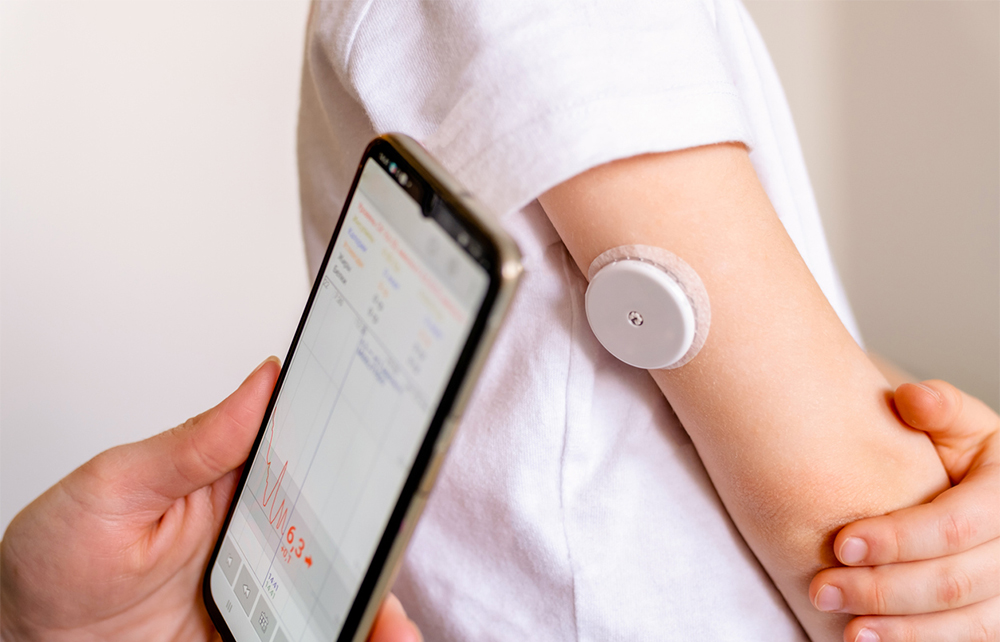At £300 a go, the Zoe is a reassuringly expensive accessory. It has a recognisable logo and even had a 200,000-strong waiting list at one point. That wouldn’t be so unusual if Zoe was a must-have handbag or jewellery, but it is a continuous glucose monitor that you stick to your arm.
Some charities ask non-diabetics to donate their wearables to be reused by people who actually need them
Continuous glucose monitors have been available to diabetics for a few years, but now non-diabetics without any particular reason to worry about their pancreas are also getting in on the act. Like the fear of gluten a few years ago, glucose levels have gone from something only those with a diagnosed medical condition ever think about to a widespread obsession. There are many people who now worry that unless they eat a pear with peanut butter, or drink a cup of vinegar before their lunch, they might end up with elevated glucose levels which could have a range of damaging effects. The vinegar and peanut butter are suggestions, or ‘hacks’, from glucose influencer the Glucose Goddess, Jessie Inchauspé, who promises to help you cut cravings, get your energy back and feel amazing.
Glucose monitors are also part of the latest wave of dietary devices and health wearables. Gone are the days when a Fitbit seemed space age: now you can ‘hack your metabolism’ with a Lumen device (£250), a breathalyser for the health addict which tells you ‘whether you’re in fat burn or carb burn through your breath’. The Whoop (£27 per month) looks like a watch strap but acts as a ‘personalised 24/7 fitness and health coach’, with biometric tracking to tell you when you are recovering well and when you need to get more sleep.

All this monitoring can give interesting results. The Zoe study doesn’t just measure participants’ blood glucose levels, but also the gut microbiome (by asking you to post faecal samples to its team of boffins) to tell you which foods work best for you. It promises to leave you healthier and more alert – and, if you want, to lose weight. Its tech was adapted by co-founder Professor Tim Spector during the Covid pandemic to help the population track their symptoms.
Now, Zoe participants can join a large-scale scientific study into how the human body and food interact. They can also find out how they personally respond to all manner of foods, ‘retrain their biology’ and learn to be healthy for life. In the first few weeks of the programme they test their gut, blood fat and blood sugar responses, before they receive a detailed report. Zoe’s glucose monitor has a limited life span and is only used for a couple of weeks. The Zoe team insist it is only useful when combined with the data and advice that its full programme offers. Similar products, including the Veri Method, run three-month cycles with a 14-day tracking period built into each to see how well its members are adapting their lifestyles.
The theory behind Veri is that our society is in ‘metabolic crisis’, also known as obesity. Zoe wants to encourage people to live healthier lives by eating food that’s good for their gut microbiome and that doesn’t send their glucose levels into orbit. We are only just starting to understand how important the bacteria in our gut can be for so many aspects of our health.
I’m as attracted to shiny new health tech kit as middle-class dads are to pressure washers, so I find the rise of all this health tech very compelling. Every time I check my watch, it tells me the time and how many steps I’ve done that day. Why not stick a few more gadgets on my body? Wouldn’t a wearable monitor that works out which foods I should be eating help me stay more alert and in a better mood? That promise will probably also sound pretty compelling to any family members or colleagues who’ve had to deal with me when I’m tired or hungry.
But the Zoe testing kit promises even more than that: it’s part of a study into what healthy postprandial blood glucose levels actually are. And in this study lies the flaw in all the popular obsession with blood glucose spikes: no one yet knows what ‘healthy’ looks like for non-diabetics. So beyond theorising that consistently elevated blood sugar can, over a long period of time, put you at risk of heart disease and other illnesses, there is a big leap here. It might be interesting to monitor your blood sugar or metabolism and see how that correlates with grumpy or spectacularly productive days, but it’s not necessarily important or useful. Glucose is supposed to increase after eating and, unless you have diabetes, your body is well-equipped to handle this through insulin production.
For diabetics, this new wider obsession with glucose can be pretty irritating. A friend with Type 1 diabetes says she finds the idea that you’d worry about perfectly healthy blood sugar spikes laughable. Glucose monitors aren’t yet available to many people in developing countries, meaning diabetics are still having to use outdated methods of monitoring their health. Some charities even ask non-diabetics to donate their wearables once they’ve finished so they can be reused by people who actually need them.
All this tech helps people feel more in control of their lives and their health, but it also overcomplicates what can be perfectly simple. If you want to lose weight, you need to be in a calorie deficit (and not one so steep that you end up gorging at the end of the diet, which is generally why diets fail, rather than because you are in a ‘metabolic crisis’). You don’t need to shell out hundreds of pounds to know that eating more fruit and vegetables will improve your health. And you definitely don’t need a flashy accessory to tell you that your body is, in fact, boringly healthy.
Isabel Hardman’s Fighting for Life: The Twelve Battles that Made Our NHS, and the Struggle for Its Future is out now.






Comments